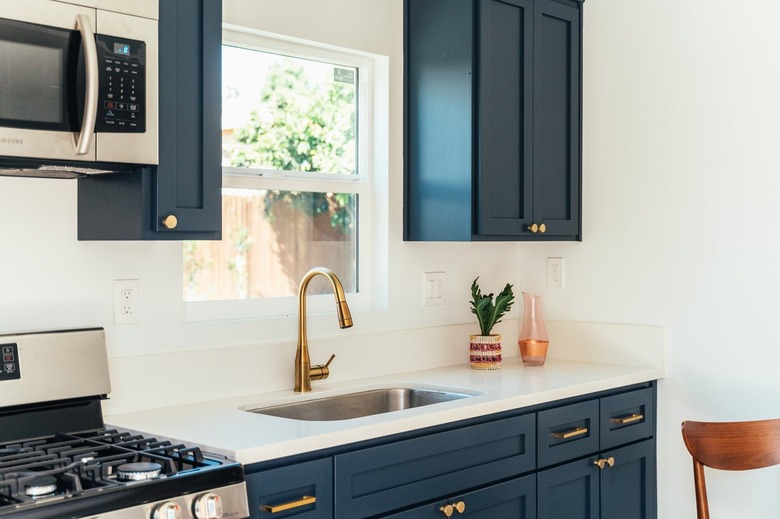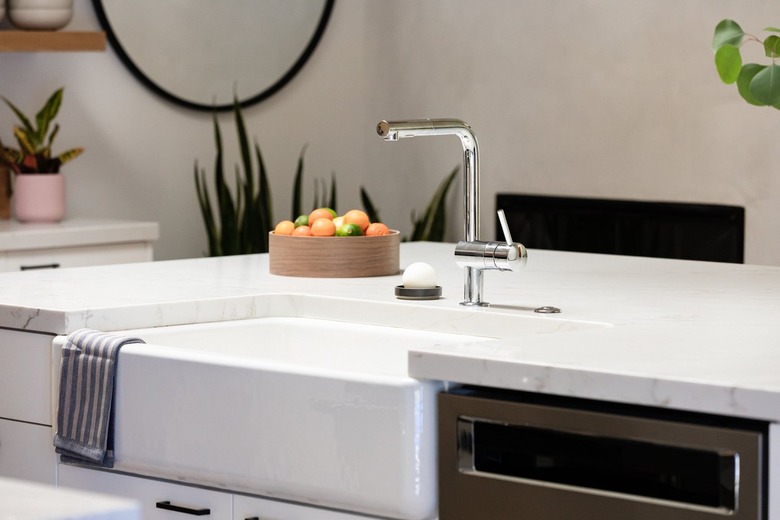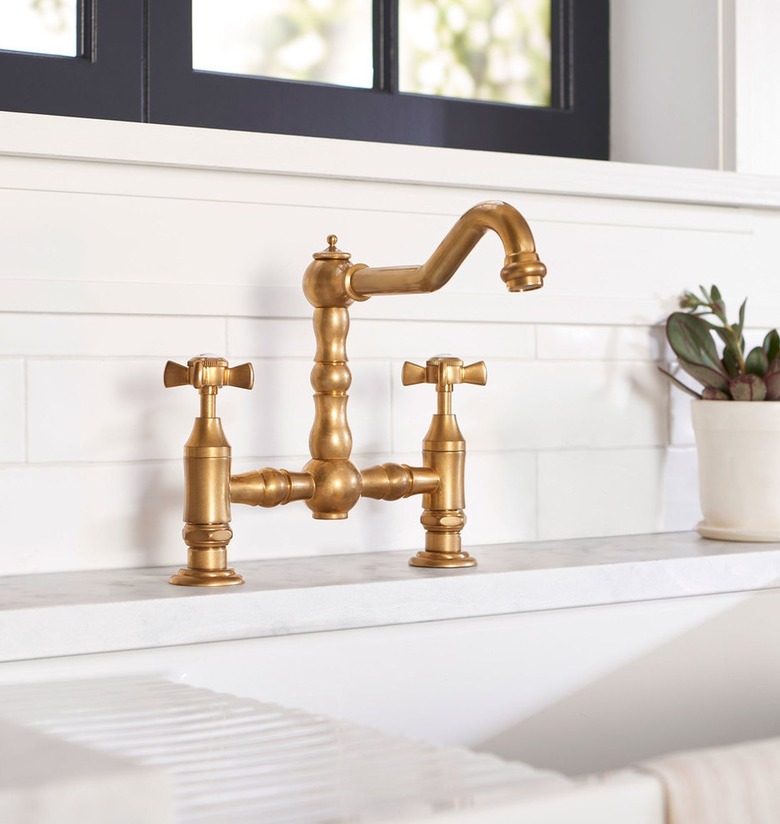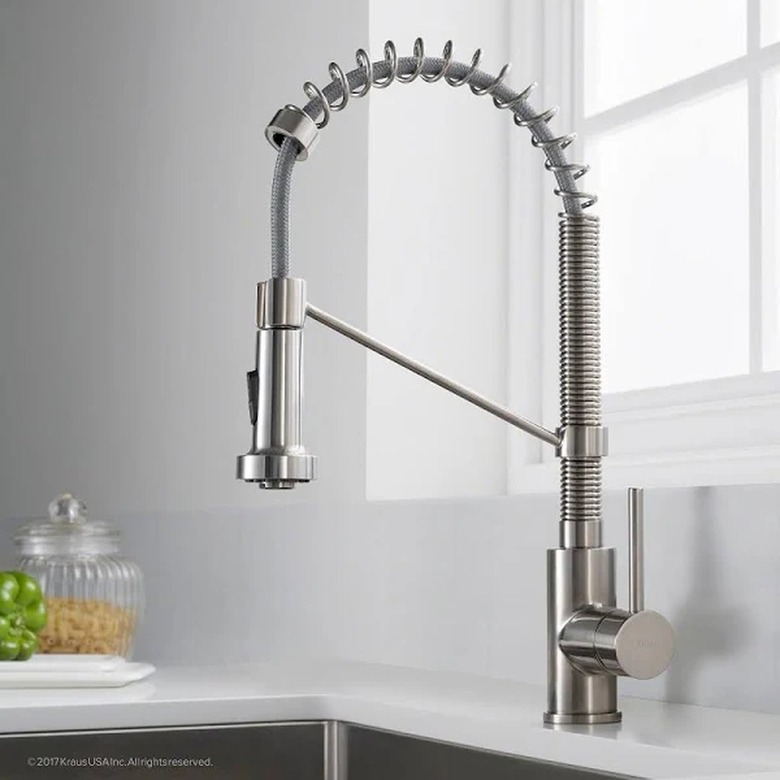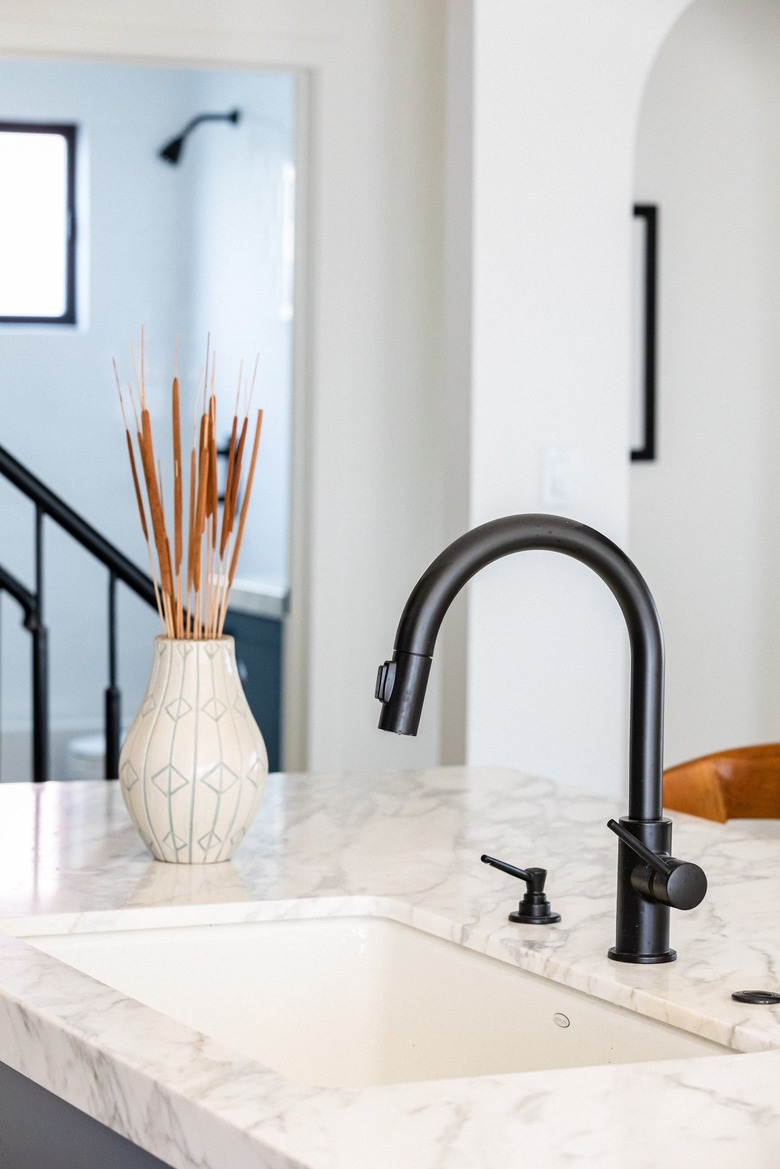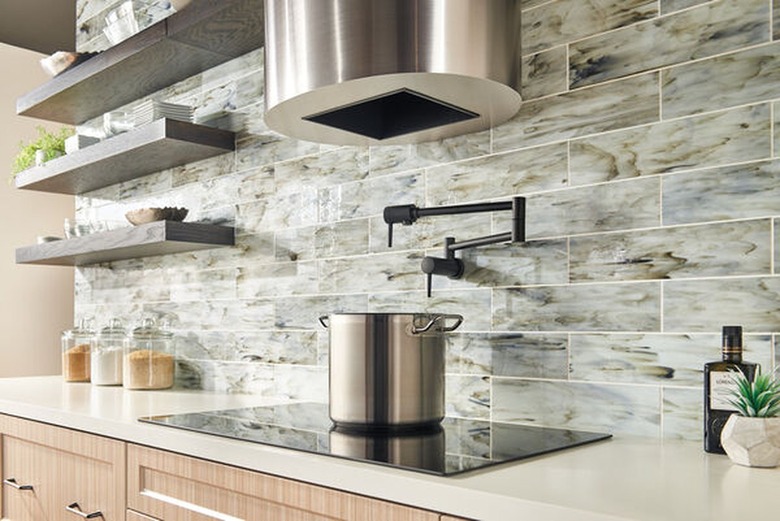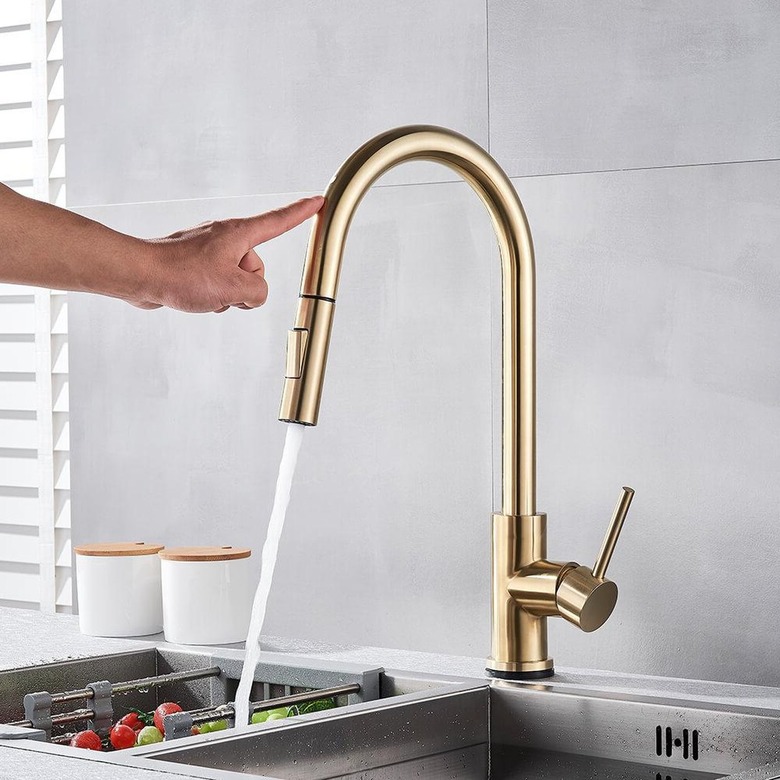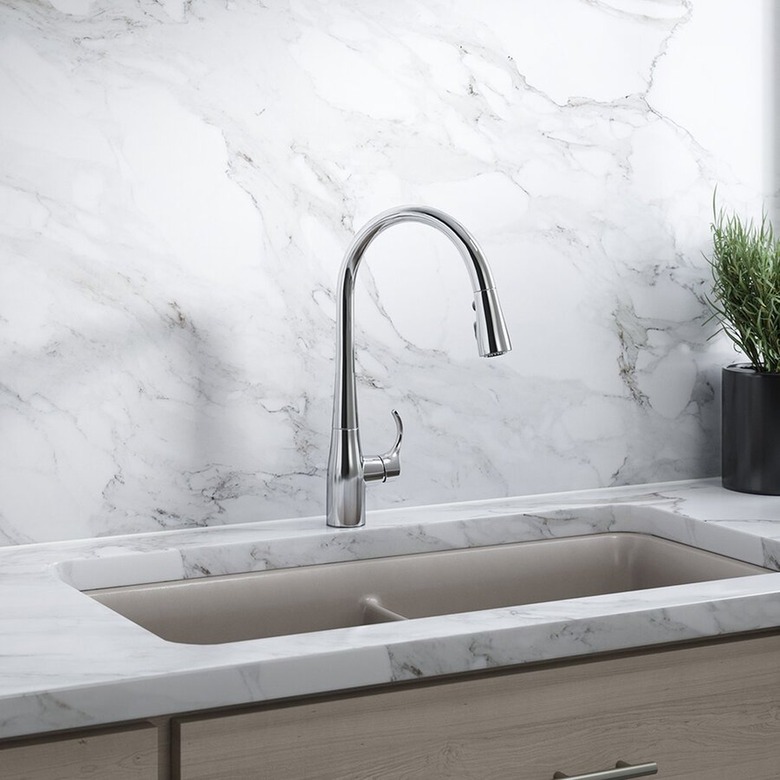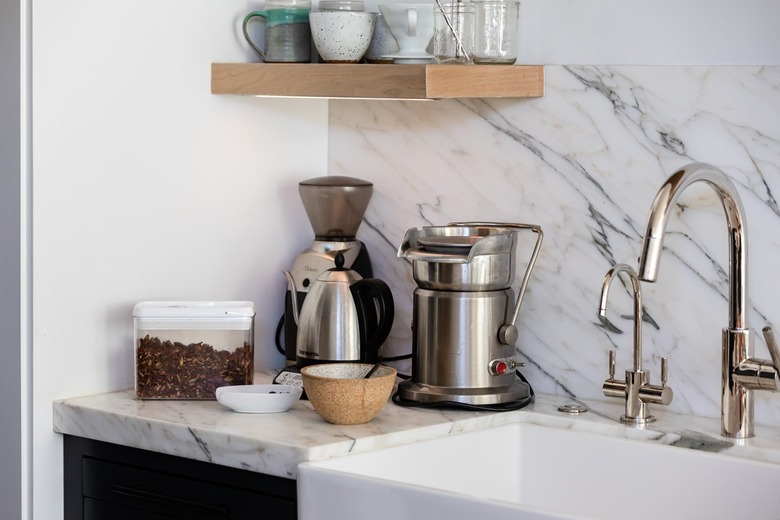8 Types Of Kitchen Faucets — And What You Should Know
If you need a new faucet for your kitchen sink, you might be surprised by just how many different types of kitchen faucets are available these days. It's not just a matter of deciding on your finish and the number of handles — modern kitchen sinks feature up to five holes, so you'll need to get a faucet that corresponds with the number of holes in your sink.
You'll also need to decide what shape you want for your spout, whether you want a pull-down or pull-out faucet, whether you want a high-tech faucet, and more. With so many varieties available on the market today, it takes a bit of research to find the best option for your home before you make a purchase.
8 Types of Kitchen Faucets
1. Single-Handle Kitchen Faucets
Cost: $30-$200
While there are seemingly infinite types of kitchen faucets, when it comes to handle numbers, there are only two types of faucets available: one-handle or two-handle faucets. With a single-handle kitchen faucet, you turn on the water flow with the handle and then adjust the handle between the two sides to allow in both hot and cold water until you reach the right temperature and water pressure.
Pros: Most homeowners prefer single-handle faucets because they can be easily controlled with one hand. Since most one-handle faucets require only a single hole for installation, they are typically the easiest faucet type to install, making them good for DIY installations — although some designs set the handle apart from the spout.
Cons: Some people feel they can better control the temperature and flow of the water with two separate handles.
2. Two-Handle Kitchen Faucets
Cost: $30-$350
With a dual-handle design, there are separate handles for cold water and hot water. To get warm water, you need to turn on both handles to find a desirable median between both water temperature and pressure. As opposed to single-handle faucets, two-handle faucets usually require a three-hole design: one for each handle and one for the spout. However, there are designs for one-hole installation where the two handles sit on each side of the spout as well as bridge-style designs that work for two holes (though these can be much more pricey than other two-handle designs).
Pros: They offer more versatility since they can accommodate sinks with one to three holes. There is also increased pressure and temperature control.
Cons: Installation is more difficult than with single-handle faucets. More parts means more can go wrong.
3. Pull-Out Kitchen Faucets
Cost: $100-$150
There is a lot of confusion when it comes to pull-down versus pull-out faucets. Although both faucet styles have a retractable spray head, a pull-out faucet will be lower and will have a longer sprayer hose with a longer reach, while a pull-down faucet will have a high arc with a shorter sprayer hose since it only sprays downward.
Pros: Pull-out faucets make it easier to spray things outside of the sink, which can make filling large items easy and can make cleaning your countertop much simpler. The hoses provide more control and can be maneuvered into any position, so they splash less. These come in more faucet styles than pull-down sprayers.
Cons: While you can angle the sprayer in more directions, the length and flexibility of the hose sometimes makes it harder to control and direct, especially when you're just aiming in the bottom of the sink. They can sometimes kink or fail to fit in spouts easily.
4. Pull-Down Kitchen Faucets
Cost: $150-$200
Pull-down faucets are like pull-out faucets only they go down instead of out of the faucet. They typically require a magnetized dock or other locking mechanism to hold the sprayer in place, which makes it easier to retract and put it back where it belongs.
Pros: Overall, pull-down faucets are preferable for those with larger and deeper sinks since they spray straight down with less fuss. They're also more comfortable for those with mobility issues since they can just be pulled down rather than needing to be twisted into place. The hoses are less prone to kinks and retraction issues.
Cons: It can be difficult to spray water outside of the sink for cleaning, and these faucets are typically only available in gooseneck shapes.
5. Pot-Filler Kitchen Faucets
Cost: $150-$200
One of the trendiest additions to high-budget kitchen remodels is the pot-filler faucet, which is an adjustable faucet installed above a stove that pours cold water directly into large pots and pans so they don't have to be carried across the kitchen. These faucets are made of a number of bendable pipes that can be pushed against the wall while cooking to keep them out of the way and then extend from the wall as needed.
Pros: These faucets are fully adjustable in order to fill pots and pans of all sizes, and they store out of the way when not in use. Their entire purpose is to make cooking quicker and easier.
Cons: Adding a faucet to a new part of your kitchen is pricey since you need to have a plumber fully redirect your cold-water line. You'll also need to completely reinstall the drywall and backsplash in order to finish the installation. Additionally, their benefits are limited, particularly considering that after using a large pot you've filled with water, you still need to lug it back to dump it out after use. Also, if the faucet leaks, it can make cooking difficult if not impossible until the issue is fixed.
6. Bar or Prep-Sink Kitchen Faucets
Cost: $50-$100
These days, many people with large kitchens find it beneficial to install a small sink elsewhere in the kitchen for a bar or prep sink. While you can install any faucet on these secondary sinks, the sinks are generally smaller than standard kitchen basins, which is why bar and prep-sink faucets tend to be smaller, too. Bar faucets are sometimes hooked up to only one water source — either a hot or cold water dispenser — so they often have only one water connection rather than two.
Pros: They are handy when working in a large kitchen, particularly when two or more people are cooking or cleaning.
Cons: Often, these faucets have only hot or cold water input, and they are expensive to install since they typically require the installation of a new water line.
7. Touch-Sensitive Kitchen Faucets
Cost: $275-$700
Two of the biggest changes in kitchen faucet technology are the addition of touch and touchless faucets. Both of these high-tech designs are easy to use when your hands are dirty since you don't need to touch the handle, but each has its own advantages and disadvantages.
Touch faucets, also known as touch-sensitive faucets, respond to physical touch anywhere on the faucet, so you can even turn them on with a touch of your forearm. While some people worry that touch faucets will turn on and off as they are cleaned, the reality is that they only respond to a quick touch, not prolonged touch or rubbing.
Pros: These are easier for kids to use, and they tend to reduce the spread of dirt, grime, and germs compared to traditional faucets.
Cons: Touch faucets require either batteries or electricity from your home — though it is worth mentioning that the risk of electrical shock is minimal — and they can be operated manually. Technology always comes at a price, and these devices are far more expensive than traditional faucets. The installation is difficult, often requiring the assistance of a plumber. Finally, it is often difficult to adjust the temperature in these devices, and some can only be adjusted below the sink.
8. Touchless Kitchen Faucets
Cost: $120-$1,000
A touchless faucet uses a sensor that can tell when a hand or object is in front of it. Some of the newest designs even offer voice activation, making it easier than ever to use your sink with dirty hands.
Pros: Touchless faucets are even cleaner than touch faucets since they are truly hands-free, and they save water by turning off quickly even when you can't use your hands. Some models allow you to adjust the temperature settings without touch, which is very convenient. Like touchless faucets, they're easier for children to use.
Cons: Touchless kitchen faucets are more expensive than traditional faucets, more difficult to install, and very difficult to repair. Pets can turn on touchless faucets, and some animals even learn to use these faucets to get fresh, running water on demand, though some pet owners consider this a pro. Like touch faucets, these require batteries or power from an outlet under the sink, though they can be manually operated as needed.
Determining the Right Kitchen Faucet for You
Determining the Right Kitchen Faucet for You
When it comes to the right type of faucet for your home, there are many things to keep in mind. First and foremost, consider how many holes you already have in your sink. While most sinks have only one to three holes, some have as many as five holes to accommodate features such as a water filtration faucet, soap dispenser, dishwasher air gap, and side sprayer.
If you're buying a new sink to go with your faucet, you can choose them together, but if you are buying a faucet for your existing sink, try to match it with how many holes you already have since cutting new holes can be challenging, and many people dislike the appearance of faucet-hole covers.
If you're looking for a professional opinion, it's good to know that plumbers typically recommend faucets made from bronze or stainless steel due to their increased durability. And for the same reason, they typically advise staying away from zinc or plastic, which are inexpensive but simply don't last as long. Plumbers often recommend models that have a pull-down or pull-out sprayer with an aerator option for increased ease of use, versatility, and water savings. Typically, they advise looking for a well-known brand, like Kohler, Delta, or Moen, with a long warranty so you can hopefully avoid leaks.
When it comes to keeping up with the trends, high-arc, professional-styled faucets with pull-down sprayers are very popular, particularly those in two-tone colors or stainless steel. While classic two-handle styles never truly go out of fashion, one-handle faucets are much more trendy right now, especially those with handles featuring art-deco or industrial features.
Always remember that it's better for a faucet to fit in with your kitchen design than to be trendy because trends fade, but most people rarely renovate their kitchen. So, if the rest of the room features vintage styling, you're best off looking for a two-handle design in brass, oiled bronze, or nickel rather than considering the currently popular professional-style kitchen sink faucets in brushed nickel and matte black.
Also, consider the clearance above your sink because if you have cabinets or shelves located just above, a high-profile pull-down faucet may make the space feel cramped. Similarly, if you have a small sink, a massive double-handle, bridge-style model may look absurdly large.
Don't forget to consider your lifestyle as well. For most people, the enhanced functionality of touchless faucets is a great addition to the kitchen, but if you don't want your pets to be able to turn on the water whenever they feel like it, this may not be the right choice. Similarly, while a two-handle faucet may provide more control over the temperature and water pressure, those with arthritis and other difficulties with grasping and turning knobs tend to find it easier to operate a single-handle faucet.
References
- Sweet Revelations: What is Touchless Kitchen Faucet? Pros and Cons of Using It
- Kitchen Guy'd: View The 12 Different Types of Kitchen Faucets to Best Suit Your Needs
- Residence Style: Myths About Touch Vs. Touchless Kitchen Faucets (You Need To Know This)
- Mr. Kitchen Faucets: Types of Kitchen Faucets
- Kitchen Faucet Blog: How to Adjust Temperature on Touchless Kitchen Faucets
- Toulmin Kitchen & Bath: Reasons Not To Include a Pot Filler In Your New Kitchen Design
- Y Lighting: Perks of a Bar Faucet
- My Face Hunter: What Kitchen Faucets Do Plumbers Recommend
- Industry Standard Design: The Top 10 Kitchen Faucet Trends 2021
- HomeAdvisor: How Much Does It Cost To Install Or Replace A Faucet?
